We’ve all been there. You click on a listicle that touts amazing insights and simple tips, only to be presented with worthless clickbait. Listicles often have a bad reputation for being low-quality and providing little value to their readers.
However, when done right, a listicle can get both clicks and share helpful insights. These well-written listicles can play an important role in your content strategy.
In fact, this post about listicles is primarily a list post itself. Here, we're going to dive into what a listicle is, how to write a high-quality article, and listicle ideas to help you generate engaging content for your readers.
What is a listicle?
Simply put, a listicle is an article written in list format. Each list item will typically include a few sentences or multiple paragraphs to educate or delight readers. For example, you might read a fun listicle, like "The Top 10 Movies of 2020," or a more informational one, like "7 Steps to Build a Website."
1. Make sure your content makes sense in list format.
Before you begin writing your listicle, research to ensure your topic fits into a list format.
If you search for your intended keyword and find most marketers are creating “Ultimate Guides” on the topic, it's better to avoid a listicle format.
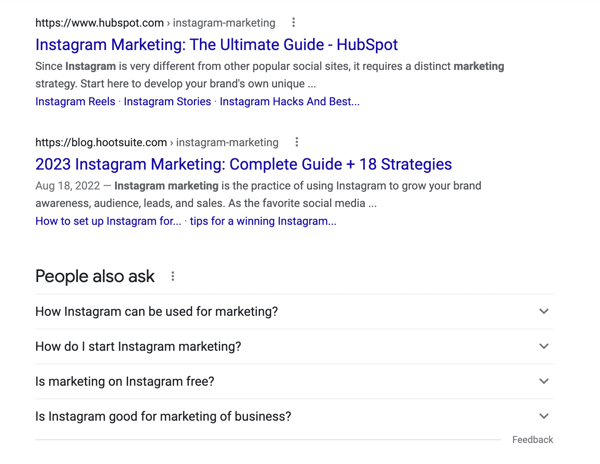
For instance, perhaps you need to write about "Instagram Marketing."
While you'd initially planned on titling the piece "10 Best Instagram Marketing Tips," your research has uncovered plenty of other angles you'd like to include, such as "why Instagram marketing is important" and "how to create compelling content on Instagram."
These sections might fit better in an "Ultimate Guide to Instagram Marketing" instead of a listicle.
If you choose to create a listicle, each list item must match the topic. To create a high-quality listicle, your content must be consistent and parallel.
If you're writing a list of best practices, you should only have best practices in your list — sneaking examples will confuse your audience.
Remember: You can always create another listicle for examples later on.
2. Include valuable takeaways — no fluff!
The most significant indicator of a lousy list post is one that contains a ton of fluff and no tangible, valuable takeaways for the reader. Here's an example of what we mean:
3 Ways to Improve Your Social Media Marketing
- Be unique! Do something to stand out from your competitors.
- Take risks. Try out-of-the-box ideas.
- Measure results! Use your analytics to tell you what's working.
What a fantastic list post! I've learned absolutely nothing. Of course, you should do all these things in your social media marketing. But it needs to tell you how to do them.
Your listicle should give readers more than just a list of things to do and expect them to figure out how to do them themselves. It should also include valuable content that tells readers how to do each step.
An excellent list post nixes the fluff and concretely explains each item in detail. Not every tip will be new to your reader.
However, if they walk away thinking, "Well, I already put numbers 3, 4, and 6 into practice, but I can't believe I've been missing out on numbers 1, 2, and 5!" — then you've probably got yourself a high-quality list.
Some listicles are meant to be more fun, but you can still include valuable takeaways. For example, the "Top Ten Best Ads of 2020" can be primarily visual, but it's still essential you include advice your readers can use to create better ads for themselves.
Featured Resource: Listicle Blog Post Template

3. Link to more in-depth information when necessary.
One of the ways you can add value is to direct readers to other resources when necessary.
Great list posts are comprehensive, so they can get long and unwieldy. If this is the case, consider pointing your readers to another place for more in-depth information.
For example, we recently wrote a list post entitled “Email Deliverability: 5 Quick & Effective Ways to Increase It.” The last tip in the list was "Check to see your emails' legality" and mentioned GDPR, which could be a blog post in itself. In fact, it already is.
Giving our readers enough information for that section to be truly helpful would have involved copying and pasting the entirety of our GDPR post into our listicle. That wouldn't have been the most beneficial choice (and also might've hurt our SEO).
Instead, we explained the tip in a moderate amount of detail and then directed readers to the other post where they could find more in-depth information if they needed it.

Feel free to do this in your own listicles. If you have to link to an external resource because you haven't written the post yourself — excellent.
You've just passed off some link love, and you also now have another article idea for your blogging backlog.
4. Explain list items using relatable examples.
Sometimes one of the best ways to adequately explain a point on your list is to use an example to support it. Of course, real examples are ideal, but sometimes even a hypothetical one works just as great.
When selecting or creating an example, keep it as relatable as possible to your readers. This can be tricky if your blog's audience comprises a variety of readers from different industries or businesses (like ours). The key here is to keep your examples general so everyone can relate.
For instance, in HubSpot's listicle "17 Fun (Not Cheesy) Ice Breaker Games Your Employees Will Enjoy," item 24 (Two Truths and a Lie) needed clarification for readers who haven't played the game before.
To illustrate the game, I provided a personal example using a hypothetical example:
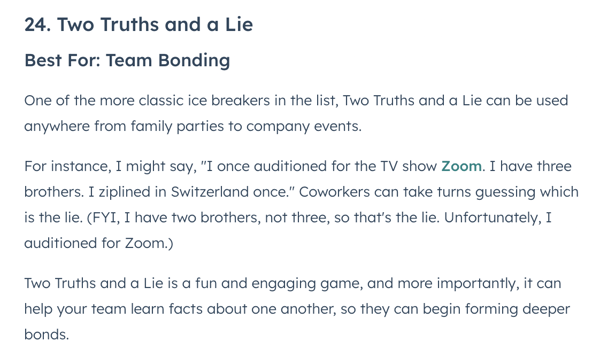
Ideally, most readers will find this example helpful for understanding the game's premise and how it works. Plus, it makes the content more interesting to read.
5. Number your items.
This is an easy one. If you're writing a listicle — especially when you use a number in the title of your list post — number your list items.
This is particularly important when you have a long list because readers want to gauge their progress as they're reading through the list (i.e., "only halfway to go" or "I'm almost done!").
Readers may also like to reference particular points on a list later or share them with others.
Being able to refer to a specific number rather than saying, "I think it's near the bottom of the list" or "It's the fourth bullet point down" is a much more user-friendly experience for your blog audience.
Make things easy for your readers.
6. Include an appropriate number of list items.
While talking about numbers, let's clear up some misconceptions about them. Listicle writers believe you should choose a number before writing your list and ensure you have enough points to fit that number.
We disagree.
Sitting down and saying you're going to write a list of 14 items makes no sense. What if only 11 solid, valuable items make up the list? Should you come up with three lower-quality items to achieve your goal of 14?
Just be comprehensive. For example, this very listicle how-to post includes ten steps for writing a listicle because that's how many I thought were individually valuable and indicative of a high-quality list post for this particular subject.
Originally I had brainstormed 11, but as I started writing, I cut one out because it wasn't that different from another point, and they could easily be represented as one.
As we mentioned before, listicles can quickly become unwieldy. So when you start drafting your listicle, decide how granular you want to make your topic. This will help make your list more manageable. The title you craft can also help you stay focused.
For example, if you work for a plumbing company and want to write a listicle about how you can unclog a drain. You might stick to "The Top 4 Ways to Unclog a Drain," rather than writing a long list post covering "The 50 Different Ways to Unclog a Drain."
Furthermore, conduct tests and research to glean some best practices for your list posts. An internal study of our blog revealed that posts for which the title indicated six items or fewer didn't perform as well as when the title indicated the list contained seven or more items.
The lesson? While we sometimes still write lists posts containing six or fewer items, we don't include the number in the title for those posts. We might try to title it "Why Every Marketer Needs a CRM" instead of "3 Reasons Every Marketer Needs a CRM."
7. Use category buckets for longer lists.
When we published "34 Millennial Stats That Marketers Need to Know," we broke up the statistics into five sections:
- "General Stats and Market Opportunities."
- "Social Media & Digital Habits."
- "Behaviors and Financial Factors."
- "Education and Work."
- And "Political and Societal Views.”
- If some of our readers don't care about the average millennial's financial situation, they can quickly scan the post and avoid that section. Perfect!
If some of our readers don't care about the average millennial's financial situation, they can quickly scan the post and avoid that section. Perfect!
If your listicle seems long or unruly, consider breaking it into subcategories to help readers scan for what they're looking for and feel more relaxed at first glance.
8. Logically order each step.
Like any other post you write, your list should flow and tell a story. How you do this will depend on the subject and contents of your list, but here are some great organizational structures to choose from:
- Alphabetical (great for glossaries).
- Chronological (great for step-by-step guides).,
- Popularity/importance, like most to least or least to most (great for top 10/20/50 lists).
Another best practice is to emphasize your strongest points at the beginning, middle, and end of your list to keep readers engaged throughout the article.
When I sat down and brainstormed this list, it was just that — a brainstormed list. It was unorganized and all over the place. I rearranged the furniture once I'd identified all the points I wanted to include.
Sometimes your list points will practically arrange themselves (e.g., "5 Steps to Do X"), and sometimes there won't be as obvious a story (e.g., "20 Ways to Do Y"). Just put the time into figuring it out and ordering your items as logically as possible.
9. Make sure your listicle is consistent.
I'm not as strict about this one as some listicle purists, but your listicle should have a consistent and parallel look. Failing to do so only confuses readers.
Here are some helpful guidelines to consider:
- Try to keep sections similar in length.
- Use the same header style to highlight your list items, and make sure they stand out.
- Make sure your list item headers are written in a parallel fashion (i.e., if it's a list of action items, each should be led with a verb).
- Finally, use images and bullet points to break up text when appropriate.
10. Have a clear and catchy title.
As we mentioned at the beginning of this post, one of the reasons people have always loved listicles is because they know exactly what — and how much — they'll get out of them.
There is no guesswork involved, and your expectations are very clear for your readers. Make sure your title epitomizes that.
A compelling listicle title should accomplish three things to entice readers actually to read the post:
- Capture the readers' attention
- Clearly indicate the value or what the reader will learn
- Suggest how much they will learn with a number.
For example, consider this post, "5 Steps to Create an Outstanding Marketing Plan [Free Templates]." Do you wonder what this post will be about? Not at all.
You know that you'll learn how to create a marketing plan (in 5 steps), and you'll have templates if you need help.
Listicle Examples
As marketers, we're often tasked with writing about drier topics to educate our viewers and attract leads. A listicle can help the reader scan for the information they need and feel less overwhelmed by the amount of content.
Let's explore a few examples to inspire you.
1. HubSpot's "6 Secrets to Achieving Work-Life Balance, According to HubSpot Marketing Managers"

This post from HubSpot explores how you can achieve work/life balance, so you can be your best self every day.
What we love: This post includes plenty of quotes from marketing managers explaining their secrets. Quotes are a great way to provide value to your readers.
2. Buzzfeed's "24 Of The Most Anticipated LGBTQ+ Books Of 2023"
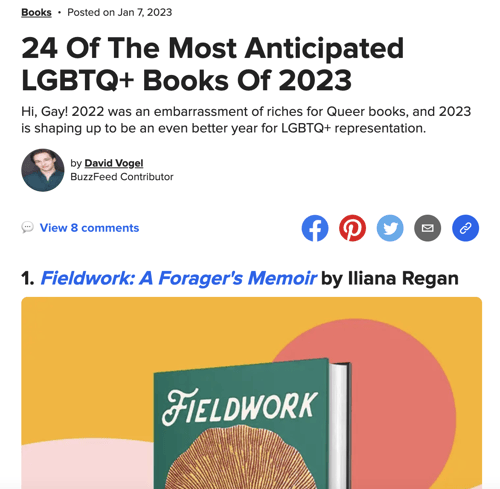
When it comes to book reviews, Buzzfeed knows the right formula. The site creates listicles of both recent releases, as well as titles that will be hitting shelves soon.
What we love: Each item on this list includes a release date for the book, as well as a summary. The listicle also links to where readers can order the book.
3. Southern Living’s "Soups To Make Every Month Of 2023"
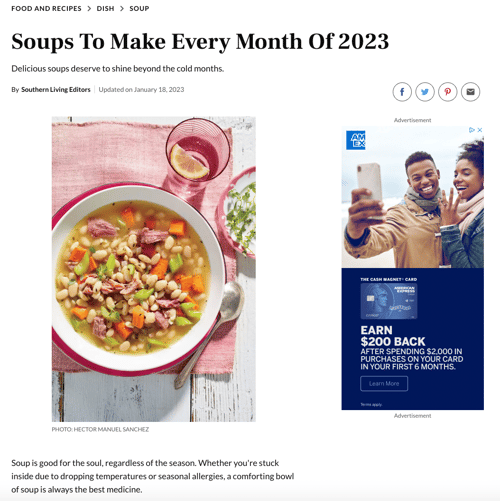
When it comes to cooking, what’s in season changes every month. Southern Living blends the best of a cooking calendar and a listicle for this collection of soup recipes.
What we love: This list makes use of clever organization, ordering recipes by month. And with 12 recipes highlighted, this listicle is easy to digest.
4. UpgradedPoints’ “The 12 Best Websites for Booking Flights at the Cheapest Prices”
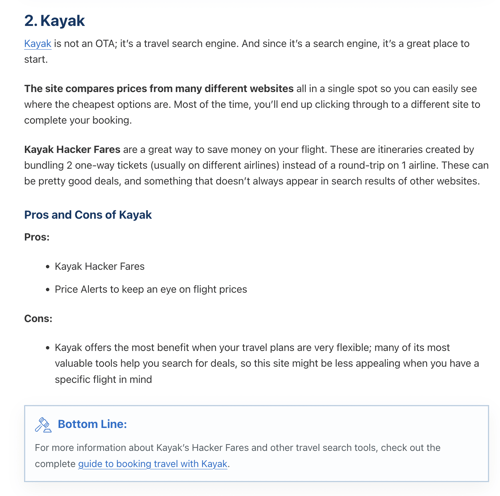
UpgradedPoints created a listicle to help travelers save on their next vacation. This article gathers sites that offer flight discounts, including a list of pros and cons for each.
What we love: At the end of each list item, the author includes a “hot tip” that can help readers save even more. By using icons and distinct colors with this text, this tidbit draws readers in.
5. Polygon’s "The Best Super Bowl Commercials of 2023"

Whether or not you watched the big game, everyone at the office will be talking about the commercials. Polygon gathers the ads everyone will be discussing in this article.
What we love: It’s not enough to describe the ad. People need to see it. This post breaks up chunks of text with videos of the ads themselves.
Now that we've explored some examples, let's dive into some ideas you can use to create yours.
Listicle Ideas
Finally, let's explore some listicle ideas to help your marketing team brainstorm highly engaging content for your readers.
We'll explore a few more tactical pieces you might write for an ecommerce, B2C, or B2B company, but we'll also dive into some fun, "trendier" ideas if you work for a publication looking to expand your reach.
Listicle Ideas For Ecommerce or B2C Companies
- 14 Essential Ways to Build a Timeless Wardrobe
- How to Apply Black Lipstick in Three Easy Steps
- 20 Things You’ll Need in Your First Apartment
- 13 Things You Should Know Before Buying a Sofa
- The 7 Best Sustainable Furniture Companies
Listicle Ideas For B2B Companies
- How to Choose a CRM in 4 Easy Steps
- The 11 Best Website Builders
- 5 Steps to Creating a Marketing Playbook
- 3 Steps to Create a Better About Us Page
- 7 Communication Channels Your Team Needs in 2023
- 12 Marketers Tell Us Their Favorite Marketing Campaigns of 2023
Listicle Ideas For Publications Looking to Trend Online
- How to Make These 3 Meals With Only 5 Ingredients
- 10 Cool Gadgets You'll Definitely Need This Summer
- 7 Hilarious Videos Trending on YouTube Right Now
- How to Become an Entrepreneur, According to 11 Successful Ones
- If You're a Leader, You Need to Accept Some Harsh Truths. These Seven CEOs Explain Why.
There you have it! Remember that listicles should serve the same purpose as any other marketing content — to attract the right audience to your products or services.
Sit down with your team and brainstorm challenges your readers might be facing, and then decide whether that challenge can be solved with a step-by-step guide or a list of tools (that includes yours).
Now, you're well on your way to having more listicles in your content strategy. Happy planning!
from Marketing https://blog.hubspot.com/blog/tabid/6307/bid/32105/the-top-10-qualities-of-high-quality-list-posts.aspx
We’ve all been there. You click on a listicle that touts amazing insights and simple tips, only to be presented with worthless clickbait. Listicles often have a bad reputation for being low-quality and providing little value to their readers.
However, when done right, a listicle can get both clicks and share helpful insights. These well-written listicles can play an important role in your content strategy.
In fact, this post about listicles is primarily a list post itself. Here, we're going to dive into what a listicle is, how to write a high-quality article, and listicle ideas to help you generate engaging content for your readers.
What is a listicle?
Simply put, a listicle is an article written in list format. Each list item will typically include a few sentences or multiple paragraphs to educate or delight readers. For example, you might read a fun listicle, like "The Top 10 Movies of 2020," or a more informational one, like "7 Steps to Build a Website."
1. Make sure your content makes sense in list format.
Before you begin writing your listicle, research to ensure your topic fits into a list format.
If you search for your intended keyword and find most marketers are creating “Ultimate Guides” on the topic, it's better to avoid a listicle format.

For instance, perhaps you need to write about "Instagram Marketing."
While you'd initially planned on titling the piece "10 Best Instagram Marketing Tips," your research has uncovered plenty of other angles you'd like to include, such as "why Instagram marketing is important" and "how to create compelling content on Instagram."
These sections might fit better in an "Ultimate Guide to Instagram Marketing" instead of a listicle.
If you choose to create a listicle, each list item must match the topic. To create a high-quality listicle, your content must be consistent and parallel.
If you're writing a list of best practices, you should only have best practices in your list — sneaking examples will confuse your audience.
Remember: You can always create another listicle for examples later on.
2. Include valuable takeaways — no fluff!
The most significant indicator of a lousy list post is one that contains a ton of fluff and no tangible, valuable takeaways for the reader. Here's an example of what we mean:
3 Ways to Improve Your Social Media Marketing
- Be unique! Do something to stand out from your competitors.
- Take risks. Try out-of-the-box ideas.
- Measure results! Use your analytics to tell you what's working.
What a fantastic list post! I've learned absolutely nothing. Of course, you should do all these things in your social media marketing. But it needs to tell you how to do them.
Your listicle should give readers more than just a list of things to do and expect them to figure out how to do them themselves. It should also include valuable content that tells readers how to do each step.
An excellent list post nixes the fluff and concretely explains each item in detail. Not every tip will be new to your reader.
However, if they walk away thinking, "Well, I already put numbers 3, 4, and 6 into practice, but I can't believe I've been missing out on numbers 1, 2, and 5!" — then you've probably got yourself a high-quality list.
Some listicles are meant to be more fun, but you can still include valuable takeaways. For example, the "Top Ten Best Ads of 2020" can be primarily visual, but it's still essential you include advice your readers can use to create better ads for themselves.
Featured Resource: Listicle Blog Post Template

3. Link to more in-depth information when necessary.
One of the ways you can add value is to direct readers to other resources when necessary.
Great list posts are comprehensive, so they can get long and unwieldy. If this is the case, consider pointing your readers to another place for more in-depth information.
For example, we recently wrote a list post entitled “Email Deliverability: 5 Quick & Effective Ways to Increase It.” The last tip in the list was "Check to see your emails' legality" and mentioned GDPR, which could be a blog post in itself. In fact, it already is.
Giving our readers enough information for that section to be truly helpful would have involved copying and pasting the entirety of our GDPR post into our listicle. That wouldn't have been the most beneficial choice (and also might've hurt our SEO).
Instead, we explained the tip in a moderate amount of detail and then directed readers to the other post where they could find more in-depth information if they needed it.

Feel free to do this in your own listicles. If you have to link to an external resource because you haven't written the post yourself — excellent.
You've just passed off some link love, and you also now have another article idea for your blogging backlog.
4. Explain list items using relatable examples.
Sometimes one of the best ways to adequately explain a point on your list is to use an example to support it. Of course, real examples are ideal, but sometimes even a hypothetical one works just as great.
When selecting or creating an example, keep it as relatable as possible to your readers. This can be tricky if your blog's audience comprises a variety of readers from different industries or businesses (like ours). The key here is to keep your examples general so everyone can relate.
For instance, in HubSpot's listicle "17 Fun (Not Cheesy) Ice Breaker Games Your Employees Will Enjoy," item 24 (Two Truths and a Lie) needed clarification for readers who haven't played the game before.
To illustrate the game, I provided a personal example using a hypothetical example:

Ideally, most readers will find this example helpful for understanding the game's premise and how it works. Plus, it makes the content more interesting to read.
5. Number your items.
This is an easy one. If you're writing a listicle — especially when you use a number in the title of your list post — number your list items.
This is particularly important when you have a long list because readers want to gauge their progress as they're reading through the list (i.e., "only halfway to go" or "I'm almost done!").
Readers may also like to reference particular points on a list later or share them with others.
Being able to refer to a specific number rather than saying, "I think it's near the bottom of the list" or "It's the fourth bullet point down" is a much more user-friendly experience for your blog audience.
Make things easy for your readers.
6. Include an appropriate number of list items.
While talking about numbers, let's clear up some misconceptions about them. Listicle writers believe you should choose a number before writing your list and ensure you have enough points to fit that number.
We disagree.
Sitting down and saying you're going to write a list of 14 items makes no sense. What if only 11 solid, valuable items make up the list? Should you come up with three lower-quality items to achieve your goal of 14?
Just be comprehensive. For example, this very listicle how-to post includes ten steps for writing a listicle because that's how many I thought were individually valuable and indicative of a high-quality list post for this particular subject.
Originally I had brainstormed 11, but as I started writing, I cut one out because it wasn't that different from another point, and they could easily be represented as one.
As we mentioned before, listicles can quickly become unwieldy. So when you start drafting your listicle, decide how granular you want to make your topic. This will help make your list more manageable. The title you craft can also help you stay focused.
For example, if you work for a plumbing company and want to write a listicle about how you can unclog a drain. You might stick to "The Top 4 Ways to Unclog a Drain," rather than writing a long list post covering "The 50 Different Ways to Unclog a Drain."
Furthermore, conduct tests and research to glean some best practices for your list posts. An internal study of our blog revealed that posts for which the title indicated six items or fewer didn't perform as well as when the title indicated the list contained seven or more items.
The lesson? While we sometimes still write lists posts containing six or fewer items, we don't include the number in the title for those posts. We might try to title it "Why Every Marketer Needs a CRM" instead of "3 Reasons Every Marketer Needs a CRM."
7. Use category buckets for longer lists.
When we published "34 Millennial Stats That Marketers Need to Know," we broke up the statistics into five sections:
- "General Stats and Market Opportunities."
- "Social Media & Digital Habits."
- "Behaviors and Financial Factors."
- "Education and Work."
- And "Political and Societal Views.”
- If some of our readers don't care about the average millennial's financial situation, they can quickly scan the post and avoid that section. Perfect!
If some of our readers don't care about the average millennial's financial situation, they can quickly scan the post and avoid that section. Perfect!
If your listicle seems long or unruly, consider breaking it into subcategories to help readers scan for what they're looking for and feel more relaxed at first glance.
8. Logically order each step.
Like any other post you write, your list should flow and tell a story. How you do this will depend on the subject and contents of your list, but here are some great organizational structures to choose from:
- Alphabetical (great for glossaries).
- Chronological (great for step-by-step guides).,
- Popularity/importance, like most to least or least to most (great for top 10/20/50 lists).
Another best practice is to emphasize your strongest points at the beginning, middle, and end of your list to keep readers engaged throughout the article.
When I sat down and brainstormed this list, it was just that — a brainstormed list. It was unorganized and all over the place. I rearranged the furniture once I'd identified all the points I wanted to include.
Sometimes your list points will practically arrange themselves (e.g., "5 Steps to Do X"), and sometimes there won't be as obvious a story (e.g., "20 Ways to Do Y"). Just put the time into figuring it out and ordering your items as logically as possible.
9. Make sure your listicle is consistent.
I'm not as strict about this one as some listicle purists, but your listicle should have a consistent and parallel look. Failing to do so only confuses readers.
Here are some helpful guidelines to consider:
- Try to keep sections similar in length.
- Use the same header style to highlight your list items, and make sure they stand out.
- Make sure your list item headers are written in a parallel fashion (i.e., if it's a list of action items, each should be led with a verb).
- Finally, use images and bullet points to break up text when appropriate.
10. Have a clear and catchy title.
As we mentioned at the beginning of this post, one of the reasons people have always loved listicles is because they know exactly what — and how much — they'll get out of them.
There is no guesswork involved, and your expectations are very clear for your readers. Make sure your title epitomizes that.
A compelling listicle title should accomplish three things to entice readers actually to read the post:
- Capture the readers' attention
- Clearly indicate the value or what the reader will learn
- Suggest how much they will learn with a number.
For example, consider this post, "5 Steps to Create an Outstanding Marketing Plan [Free Templates]." Do you wonder what this post will be about? Not at all.
You know that you'll learn how to create a marketing plan (in 5 steps), and you'll have templates if you need help.
Listicle Examples
As marketers, we're often tasked with writing about drier topics to educate our viewers and attract leads. A listicle can help the reader scan for the information they need and feel less overwhelmed by the amount of content.
Let's explore a few examples to inspire you.
1. HubSpot's "6 Secrets to Achieving Work-Life Balance, According to HubSpot Marketing Managers"

This post from HubSpot explores how you can achieve work/life balance, so you can be your best self every day.
What we love: This post includes plenty of quotes from marketing managers explaining their secrets. Quotes are a great way to provide value to your readers.
2. Buzzfeed's "24 Of The Most Anticipated LGBTQ+ Books Of 2023"

When it comes to book reviews, Buzzfeed knows the right formula. The site creates listicles of both recent releases, as well as titles that will be hitting shelves soon.
What we love: Each item on this list includes a release date for the book, as well as a summary. The listicle also links to where readers can order the book.
3. Southern Living’s "Soups To Make Every Month Of 2023"

When it comes to cooking, what’s in season changes every month. Southern Living blends the best of a cooking calendar and a listicle for this collection of soup recipes.
What we love: This list makes use of clever organization, ordering recipes by month. And with 12 recipes highlighted, this listicle is easy to digest.
4. UpgradedPoints’ “The 12 Best Websites for Booking Flights at the Cheapest Prices”

UpgradedPoints created a listicle to help travelers save on their next vacation. This article gathers sites that offer flight discounts, including a list of pros and cons for each.
What we love: At the end of each list item, the author includes a “hot tip” that can help readers save even more. By using icons and distinct colors with this text, this tidbit draws readers in.
5. Polygon’s "The Best Super Bowl Commercials of 2023"

Whether or not you watched the big game, everyone at the office will be talking about the commercials. Polygon gathers the ads everyone will be discussing in this article.
What we love: It’s not enough to describe the ad. People need to see it. This post breaks up chunks of text with videos of the ads themselves.
Now that we've explored some examples, let's dive into some ideas you can use to create yours.
Listicle Ideas
Finally, let's explore some listicle ideas to help your marketing team brainstorm highly engaging content for your readers.
We'll explore a few more tactical pieces you might write for an ecommerce, B2C, or B2B company, but we'll also dive into some fun, "trendier" ideas if you work for a publication looking to expand your reach.
Listicle Ideas For Ecommerce or B2C Companies
- 14 Essential Ways to Build a Timeless Wardrobe
- How to Apply Black Lipstick in Three Easy Steps
- 20 Things You’ll Need in Your First Apartment
- 13 Things You Should Know Before Buying a Sofa
- The 7 Best Sustainable Furniture Companies
Listicle Ideas For B2B Companies
- How to Choose a CRM in 4 Easy Steps
- The 11 Best Website Builders
- 5 Steps to Creating a Marketing Playbook
- 3 Steps to Create a Better About Us Page
- 7 Communication Channels Your Team Needs in 2023
- 12 Marketers Tell Us Their Favorite Marketing Campaigns of 2023
Listicle Ideas For Publications Looking to Trend Online
- How to Make These 3 Meals With Only 5 Ingredients
- 10 Cool Gadgets You'll Definitely Need This Summer
- 7 Hilarious Videos Trending on YouTube Right Now
- How to Become an Entrepreneur, According to 11 Successful Ones
- If You're a Leader, You Need to Accept Some Harsh Truths. These Seven CEOs Explain Why.
There you have it! Remember that listicles should serve the same purpose as any other marketing content — to attract the right audience to your products or services.
Sit down with your team and brainstorm challenges your readers might be facing, and then decide whether that challenge can be solved with a step-by-step guide or a list of tools (that includes yours).
Now, you're well on your way to having more listicles in your content strategy. Happy planning!


No hay comentarios:
Publicar un comentario